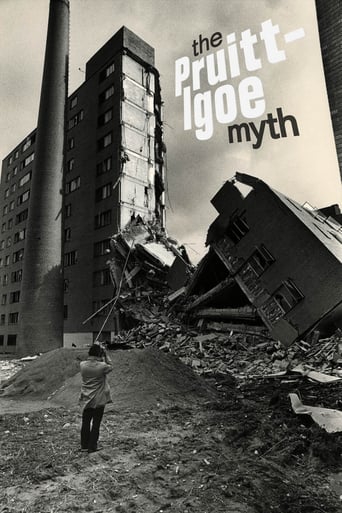nlasser
The subject matter is interesting but the execution of the film is incredibly shallow. It's only redeeming point are a few of the interviews which transcend the discussion and manage to bring out some human feeling into is what basically a town-planning policy and execution story.But as a film, it suffers greatly from the small number of people interviewed - I counted eight, of which only four or five are actual former residents. Much historical footage is used and some of it feels tacked on as a way of adding volume to what would have otherwise turned it be a documentary short. At some point you get a feeling of material being reused in order to fill the time. And that's a shame, as this is both interesting and relevant to much of our society. This case-study deserves a better retelling.
kia-hutchens
Prof. Cordova UPP 101 October 24, 2014In The Pruitt-Igoe Myth, director Chad Freidrichs, gives viewers an in-depth look at the Pruitt-Igoe project, one of St. Louis' failed attempts to urbanize the city. In this documentary, Freidrichs focuses on dispelling the myths that surround the project by interviewing past residents and establishing the real cause of why projects Pruitt-Igoe failed. In addition, this documentary sheds light on the bigger issue, of why housing projects in general fail in America.The main argument of the film is built to dispel the myths about housing projects, that Pruitt-Igoe fueled. When most people think about housing project and why they fail, they blame violence, crime, drugs, and poverty. While these things are commonly found in housing projects, they are not to blame. To prove this, Friedrichs starts by discussing the beginning of urban renewal. In 1949 the Housing Act was passed. Legalized and funded, St. Louis started urban renewal by clearing the slums and building new public housing units, Pruitt Igoe. Pruitt-Igoe was conceived to replace the tenement homes of poor residents throughout the St. Louis. The idea was to replace the slums with new high-rises, and this would solve the issue of poor neighborhoods. However this would not work out in the end. As I previously mentioned when people think of housing projects they think of crime as the root of their problem. This was not the case for Pruitt Igoe. Friedrichs points to a lack of funding as the cause of Pruitt Igoes failure in the documentary. The documentary looks in-depth at how a lack of funding led to the deterioration of Pruitt Igoe. They say the project was doomed from the beginning because the city did not have a solid plan on how to continue to fund Pruitt Igoe. When the planning for the building started, the city wrote in the plans that the rent residents would pay would never increase. As the years went on funding dwindled and the buildings deteriorated. The documentary interviewed some past residents and they told stories of how the grounds keepers stopped taking care of the building, no repairs or updates were made to the buildings, and how basically their was no one to take care of Pruitt Igoe. Another argument the documentary made was that people who live in housing projects have a community there. Many of the interviews shown in the documentary support this. Everyone they interviewed had positive happy memories of living in Pruitt Igoe despite poor conditions toward the end. They boasted of growing up there as children and always having someone to play with. The apartment styled building made it so everyone knew each other. Friedrichs use of interviews took the focus off of Pruitt Igoe being a failure and focused on the community aspect. Overall, this documentary dispels a lot of myths that surround housing projects. The documentary takes a look at a controversial aspect of urban planning over a course of decades in Pruitt Igoe. Many people put housing projects to the back of their mind or look at them as negatives blaming their problems on the residents that inhabit them. As a person who was grown and raised in St. Louis, I didn't even know that Pruitt Igoe existed as it has since been torn down. I would recommend this documentary, as I think it shows an important part of our history and portraits Pruitt Igoe in a positive light which it and its' residents deserve.
missismiggins
This has to be a valuable insight into how certain people expect everything handed to them on a plate.The documentary tries to blame the government and various social services for the failure of the project - In my opinion it fails! The blame for the failure lies squarely with the people who lived in the project.Everyone of them interviewed tries to lay the blame on the government, did the government urinate in the lifts? Did the government burn their refuse in the corridors, did the government break all of the windows and light fittings? No one involved seems to even begin to think that it is themselves to blame for all of this.Take a look at the project when it first opened, affordable clean housing, people wanted to live there.Give them a few years and they completely destroyed it.A very interesting insight into social behaviour.
ems97
The movie includes fascinating archival footage and interviews with five former residents of the public housing development. Some of these residents talked about the joyful experiences they had there, while others told harrowing stories. One of the most interesting things was listening to why they moved to the project initially. They told of how exciting it was to get into a modern development.The movie also suggests some causes for the decline of the project, such as population loss in St. Louis, lack of funding for maintenance, and the loss of manufacturing jobs to the suburbs. When I discussed the movie with friends afterwards, we remained unsure in our speculation about the true causes.

